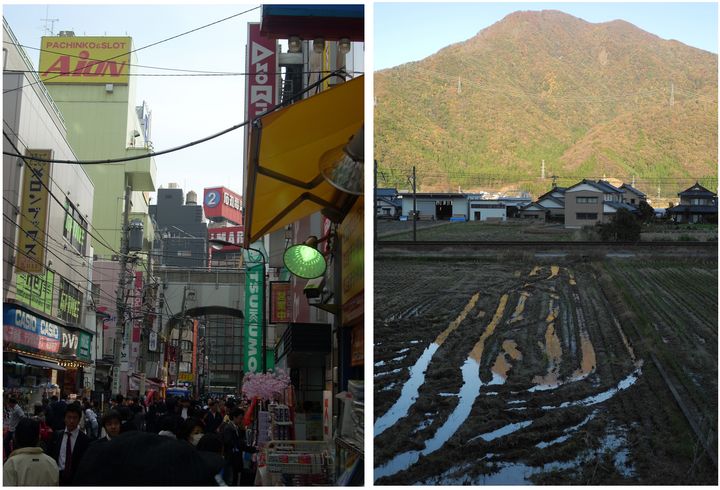
Akihabara section of Tokyo, 2008 (left), Rice Fields in Fukui Prefecture, 2017 (right) (all photos courtesy of the author)
For someone born in the Bronx and never living too far from ‘the city’, there is a bit of a mental and physical adjustment one has to go through when traveling to Japan. Tokyo, especially the Akihabara section on my first trip there, was a whirlwind of signs, symbols and an almost surreal atmosphere that was way beyond what I was accustomed to. My second trip to Japan was far different, traveling to the west coast’s Fukui Prefecture where it is more rural, with rice fields stretching out to nearby mountain ranges. This time around, the wonderful way I started each day was with an energizing breakfast at Hotel Akishatei. That entire experience of morning greetings, and the beautiful and tasty food really got me primed and ready for the day’s visual art experiences.
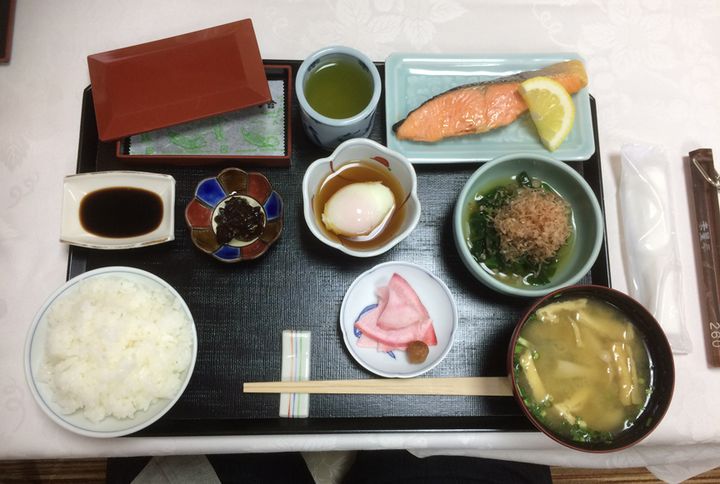
Breakfast at the Hotel Akishatei
The Tannan Art Festival
The Tannan Art Festival, which was founded in 1993 by Yutaka Hatta, is a celebration of new art. As a community that has been active and observant of International Modern and Contemporary Art for 100 years, the Fukui Prefecture of Japan is also known for its paper-making in towns like Imadate, where the highest quality paper has been produced for 1,400 years.
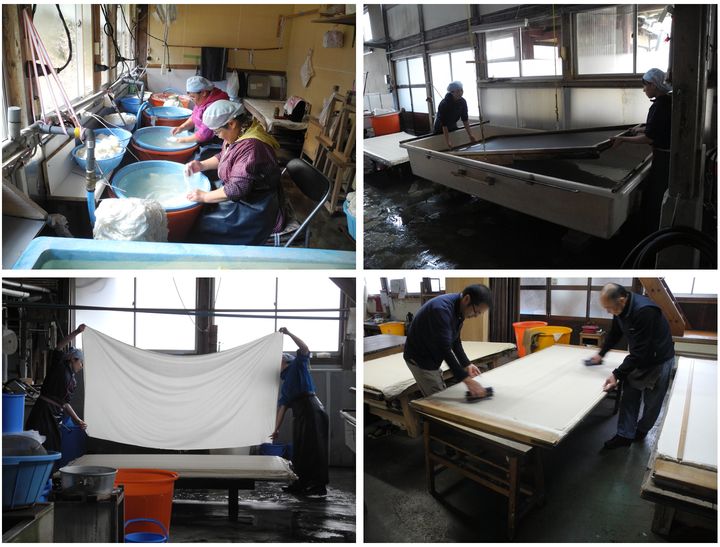
Paper making in Imadate, Japan
The exhibition, which is held at two locations: the Sabae Contemporary Art Center’s temporary space and the Sabae City Main Building Museum, reveals the many ways in which nature, tradition and contemporary thinking can extend beyond the preconceived. The following is my take on a large portion of the works displayed.
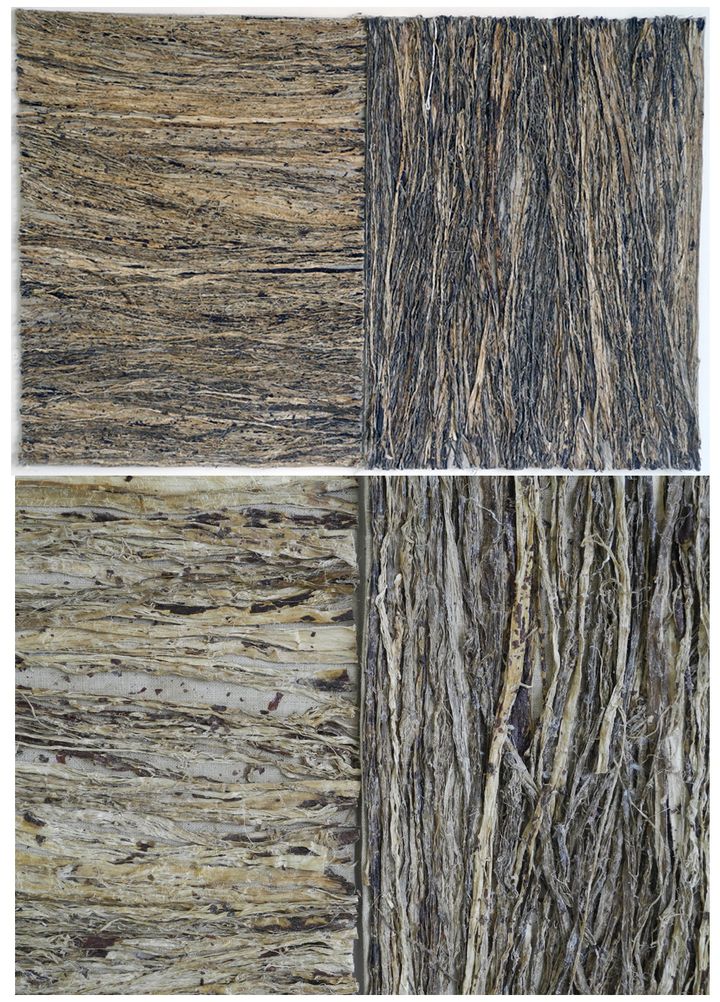
The art of Yutaka Hatta, detail (bottom)
Yutaka Hatta (Fukui, Japan) lives a life that is an inspiration to us all. Despite the fact that he lost his sight decades ago, Hatta continues at the age of 88, to create masterful work that continually teaches us new approaches to respond to the world around us in ways that ultimately feel freshly familiar. Hatta brings us back to our essence, our primordial memory of the earth before we covered it with concrete and asphalt. His art is the physical embodiment of contemplation, a state that can be both enlightening and calming for the viewer. Hatta’s work is a unique bridge between was we see and what we can feel and how our bodies and our minds process all that emotion and information. In Hatta’s art we see an energy that is ancient and modern, gestures that are as natural as wind blown grass or a raging river and as profound as any mark created by human hands – and like any compelling refined narrative, we can take what he has so generously given us and imagine a world of endless serenity.
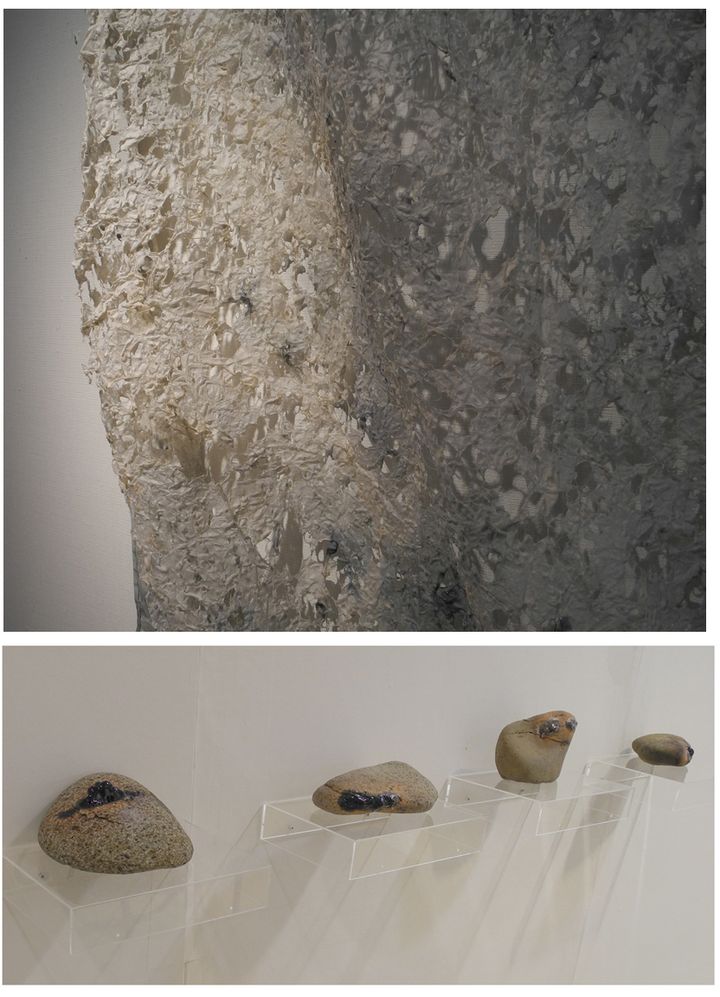
The art of Yasuhiro Shimakawa, paper detail (top), liguified rocks (bottom)
Yasuhiro Shimakawa (Fukui, Japan) works with rain and sunlight to create his highly sensitive and somewhat surreal work. He presents us with puzzling objects, making familiar materials unfamiliar, while unraveling reality in ways that our simplest preconceptions become blurred and even questionable. In one work, Shimakawa exposes a large sheet of washi paper to rain, soil and grass by placing it on the ground for days. The result is a large lace-like surface stained and holed by pummeling raindrops and penetrating earth, a true collaboration between artist and nature. With his sculptures, Shimakawa uses super-focused sunlight through a large magnifying lens to literally liquefy the surface of dense solids such as rock and brick. By doing so, the artist brings us back to the earth, to a more ancient time when the elements meant something very different than they do today – perhaps to the very beginnings of the formation of our planet.
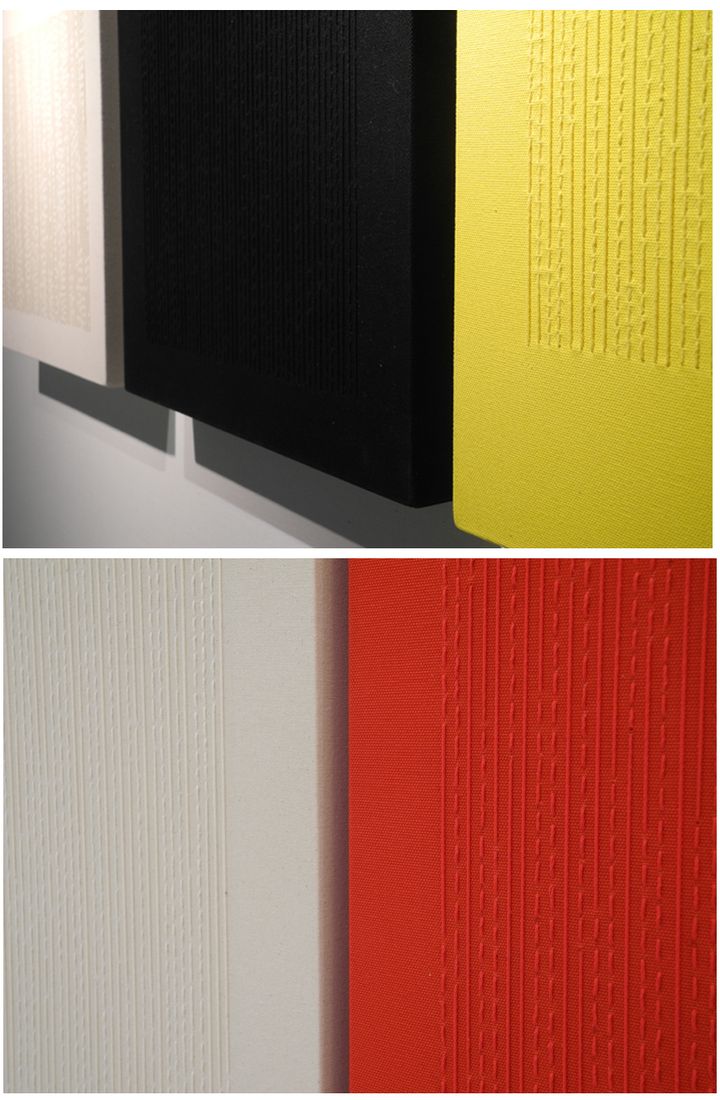
The art of Kyung Han Kim (details)
Kyung Han Kim (New York, USA) creates subtle gestures with colored thread across same colored surfaces of canvas that begs examination. The closer one gets to the work, the more intimate our experience and the more meditative the effect of his technique of carefully and methodically weaving thread through the surface of the canvas. Kim’s art harkens back to a period in time when Minimal Art and artists such as Agnes Martin and Tony Smith gave us a lot to consider with a minimal amount of detail yet we were constantly mesmerized by the depth and the achievements of their art. Kim keeps that fleeting fire burning with his focused stitching and flamboyant colors – and as we are reminded of one of the highest forms of Modern Art, we will look at the art of Kim and see a continuation of a purity of vision and a distillation of concept that produces a contemporary flair for the unexpected.
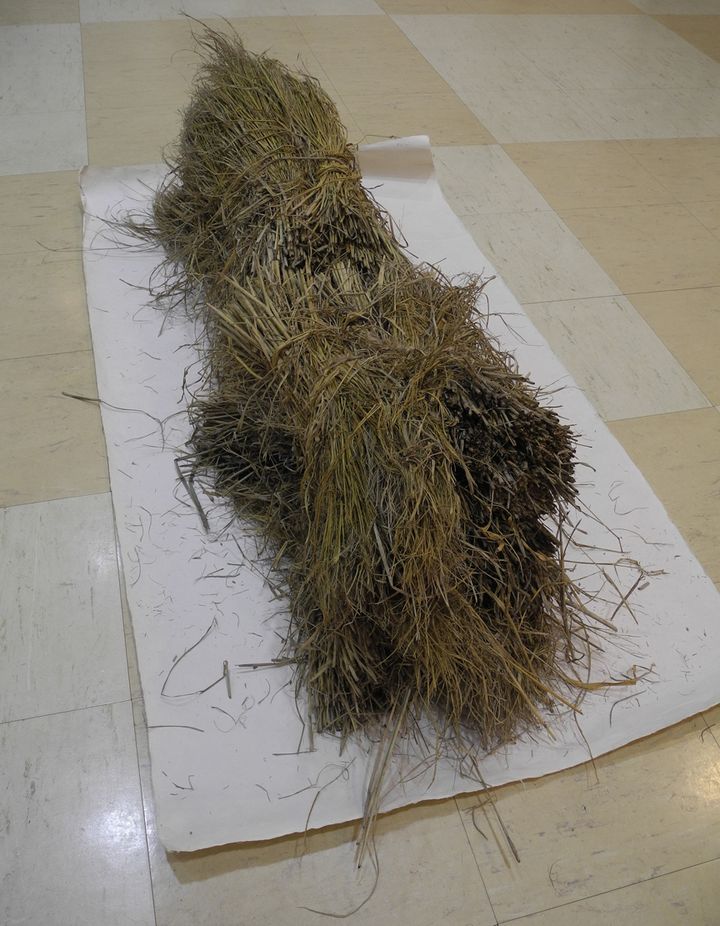
The art of Fukushi Fukuoka
Fukushi Fukuoka (Fukui, Japan) offers installations that are a celebration of nature’s bounty; a commentary on a work ethic that is ages old and honorable; and a notion that meaning and purpose can change, even cause confusion, when objects are displaced. In viewing the work of Fukuoka we see pride, persistence, even purity in the materials that mean so much in the way of paper production. We also see the material as a representation of sustainability, a connection to a 1,500-year-old tradition and the basis of a community that has great pride in its culture, and a great belief in thought and contemplation. Yet there is that fracturing of the forms, a curious design in the placement of the bails of fibers from trees, bushes and shrubs that speaks to anxious notions of an uncertain future with the way the world and its climate is rapidly changing.
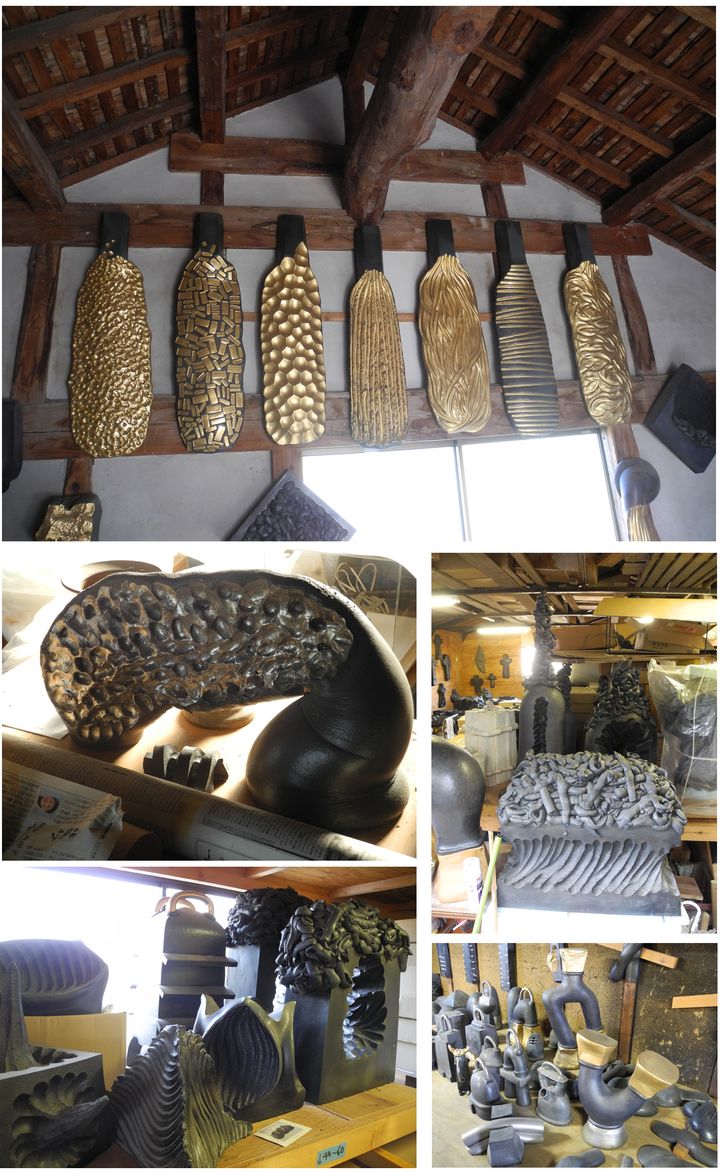
Studio details, the art of Kenji Kuze
Kenji Kuze (Ishikawa, Japan) creates ceramic objects, often in black and metallic colors, which suggest a multitude of peoples, faiths and cultures. I tend to see his work as otherworldly in their references, perhaps suggesting the earliest symbols brought here by aliens from a distant planet, icons left behind that have seeped into our collective unconscious long before we were ‘civilized’ and socializing. The sculptures may also be seen as vessels for ideas; orderly formats that can be converted into city planning or agricultural methodology. I had the opportunity to visit the studio of Kuze while in Japan and was overwhelmed by the breadth of work and the way in which he manages to continually explore the notion of multi-cultural iconography. There is also a bit of whimsy in much of the work, a playfulness that is not all hopeful and fun as a darkness often seeps through the forms adding an extra emotional dimension to the work.
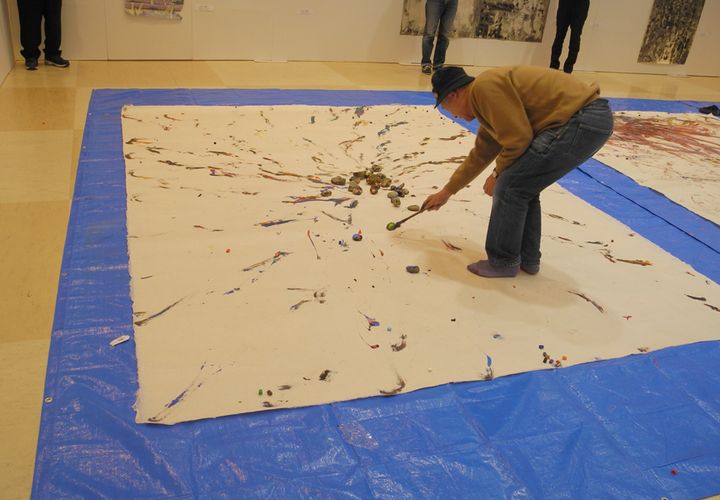
Sadaharu Horio performance art
Sadaharu Horio (Hyogo, Japan) is a performance artist who joined the Gutai Group in 1966. At the opening reception of this exhibition, Horio performed three separate works of art that were wildly automatic and chaotic, yet controlled enough to be contained to the individual papers. In each instance, the artist rapidly marked the paper with various brushes and water as he pushed and rolled a variety of irregular rocks covered in inks and paints. The resulting imagery is an explosive expression of movement in time that bridges the gap between unconscious writing and discordant mark making. With Horio’s art today, I am reminded of the works created by the Abstract Expressionists of the 1940s and 50s, yet there is that lack of control using the radically rolling rocks that I can not help but think of the far-reaching genius Yves Klein and works like “Blue Women” (1962) where the women moved independent of the artist and in reaction to music.
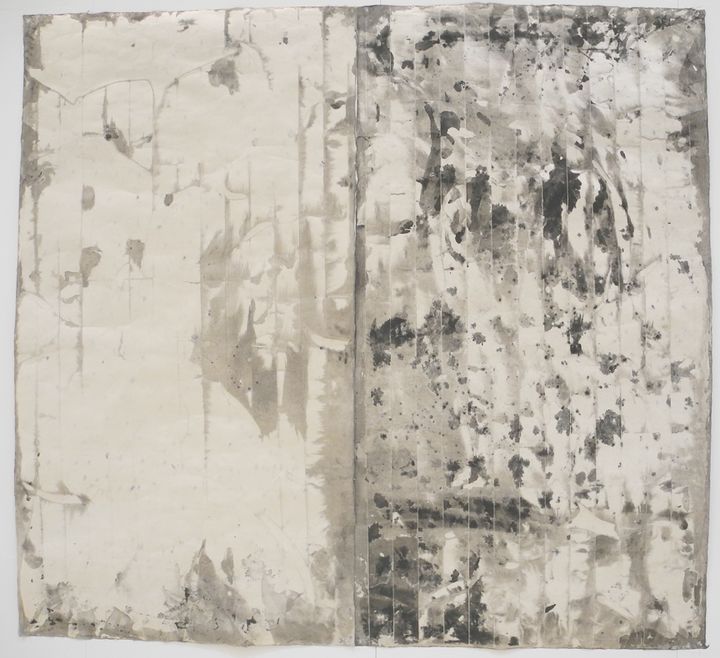
The art of Syunsuke Asakura
Syunsuke Asakura (Fukui, Japan) creates art that relays a curious balance between the magic of the materials and the structure of space and time. We see in his paintings the suggestion of the landscape, delicate movement and the uniqueness of the Sumei ink on the distinctive washi paper. Within that system, we find a most meditative journey through veils of gray and black washes that appear somehow inevitable, natural and pure. Other times, Asakura might be more deliberate in his use of ink to create wavelengths of clarity that moves in and out like the striations of earth along a canyon wall. In both instances, the artist is grounding his thoughts in the familiar while making a move toward the spiritual, as the sensitivity of his expression and the elusiveness of the journey is his ultimate statement.
Keiko Arai’s (Chiba, Japan) art reveals a harmony and a rhythm to life that is simple and necessary – sorry souls suspended in an orderly matrix of fluid and function. For sure, there is an indication of communication here, and perhaps a link to a higher power yet we cannot be sure which life form is the subject here. Perhaps it is none in particular, just a nod to the fact that there is survival in socialization and interdependence and we must not break or move beyond the physical and intellectual borders unless we strive to create something new.
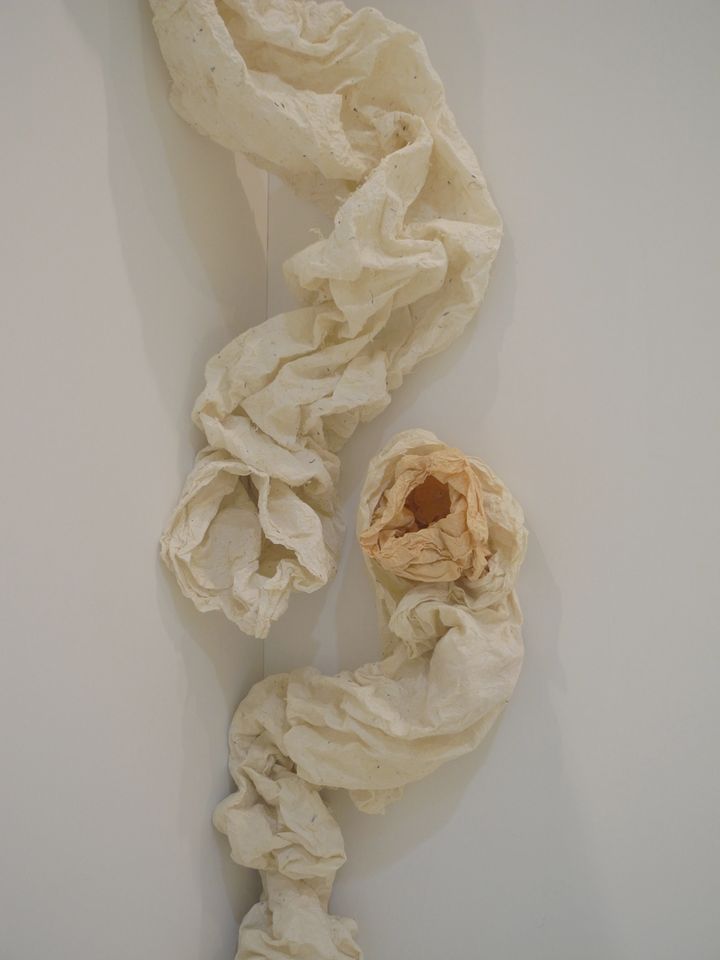
The art of Shizuko Kato (detail)
Shizuko Kato (Fukui, Japan) makes art that suggests movement and growth, while the placement of the work says intrusion or change. I say this because the softness of her materials against the hardness of the walls forms a contrast that is impactful and odd, even though we know going in that it is not meant to be permanent or practical. This piece stands more so as an independent and elusive thought, a reflection of an expression that can be seen either as anxious and twisted, or freeing and fanciful – it’s just a matter of what state of mind we are in at the time of contact, and what experiences we bring with us as we walk or travel from place to place. The important thing to remember is you do not have to make a specific determination; you only need to think about the possible narratives.
Nanae Kamo (Ishikawa, Japan) offers art that is not unlike the modulating minerals in stones or the free-formed phases of wispy clouds. We see gray ink washes creep into crevices and hollows forming edges of soft stains and sweeping gestures, and we sense an orderliness that is formed by chance and change. Yet, there is an erraticness, there are irregularities here that defy the logic while images emerge looking like great majestic birds ascending to the heavens or a coral reef slowly dying from polluted waters.
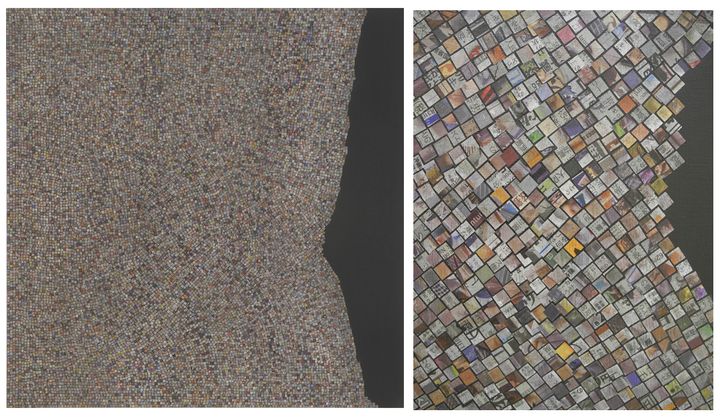
The art of Masao Sasaki (detail, right)
Masao Sasaki’s (Ehime, Japan) art at first makes me think of Hooverville, the shantytowns built all across the United States of America during the great depression. I say this because the composition looks to be a large landmass at the edge of some ocean or lake where the inhabitants, being poor and only able to build homes with the detritus and debris of a society pummeled by homelessness and poverty, can only build a ‘city’ comprised of small shacks. As one looks more deeply into the work, a mosaic of tiny squares of paper develops into patterns and movement that simultaneously expands and folds in on itself. These bizarre movements and gestures only add to the mesmerizing effects of the artist’s technique and use of collage, while the overall appearance is quite beautiful.
Yasuo Taniguchi (Fukui, Japan) creates art that reminds the viewer of the practical applications of materials, while at the same time, showing how artful one can be with basic shapes and sizes. They beg us to imagine, completing the narrative by keeping things literally and figuratively open-ended, though we may not see a specific resolution to any of the puzzles or scenarios posed here. And it is just that playfulness, that whit and whimsy behind these works where the art truly shines.
Kazuo Tsubakizaki (Hyogo, Japan) reminds me of the artist who is discovered late in life or after they pass on. You know the story: someone accidentally finds a treasure trove of unique artistic expressions in some hidden basement or attic – art that resides somewhere just outside the realm of the known. I am thinking this way as each individual element that comprises Tsubakizaki’s installation looks like a creatively modified cutting board with no particular unifying aesthetic besides the use of wood, which in this case is more than likely local cedar. As a grouping here, I can sense a scenario whereby one bit of inspiration has spawned a large series of woods crafted and coordinated in such a way as to broaden the viewers thinking about repurposing materials.
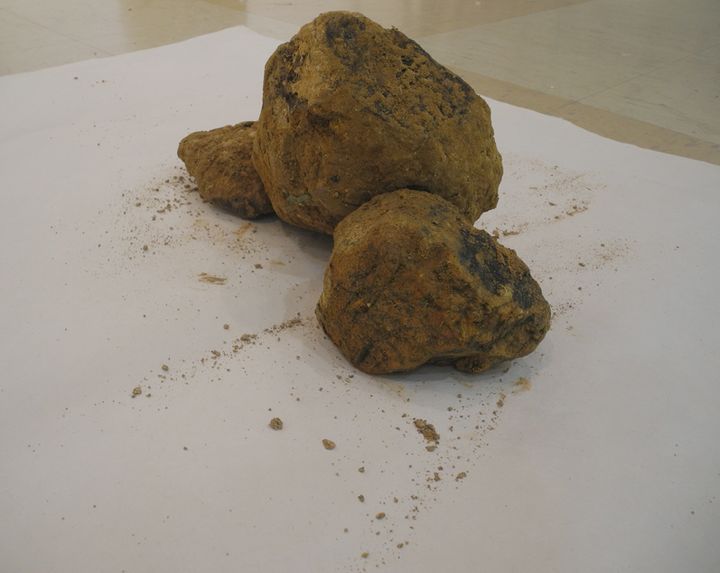
The art of Chigusa Tamamichi
Chigusa Yamamichi (Fukui, Japan) has a rather basic approach to a very contemporary thought. In using unfired clay and pristine paper, Yamamichi forms a puzzling procession of biomorphic forms that are not unlike petrified organs. There is much angst here, a turmoil of inner emotions that speaks of a soul that is tortured and tired, yet there is a ring of hope with the orderliness of the composition and the purity of the paper that perhaps, we are seeing a positive swing toward a better future where one single turn of events can change everything.
Setsuko Hasegawa’s (Okayama, Japan) minimalist approach to composition is a refreshing take on the beauty of simplicity. We look and are only asked to make one connection, between poise of placement.Sugie Nishiuchi (Hyogo, Japan) works in retail and saves all the cardboard spools inside each and every roll of cash register paper. Most are painted, spattered with color, painted solid or dotted with black then strung together creating a ritualistic looking ropes reminiscent of beaded necklaces or festive decorations. When set in a museum, they become something more as their size and richness can be fully appreciated.
Yoko Kubo (Hyogo, Japan) employs metal with a dimpled surface that is orderly and systematic. As we peer into the surface of this art we see our reflection, one that is muddled by a subtly pointed texture, and we are reminded of the soothing feeling of a falling rain on glass.
Keiko Sarusawa (Hyogo, Japan) mixes hard and soft materials to create something that looks somewhere between an ancient sea scroll and some sort of weaving tool. In either case, there is more than a hint mystery many elements to ponder.
Izumi Ueda Yuu (Lisbon Portugal) has a system whereby the narrative in the art reveals itself slowly over time. Once an overarching ink pattern seeps into the paper, the artist brings in familiar symbols that lead to more emotional aspects and individual experiences.
Masami Hayashi (Osaka, Japan) has a way of finding patterns in chaos that form subtle, wavelike modulations across the surface. The result is quite calming to the eye.
Fusae Yamashita (Fukui, Japan) relies heavily on texture to create movement, light and shadow. Think non-representational bas-relief.
Satoe Yoshimoto’s (Hiroshima, Japan) pod-like forms have a mixed message of rebirth and decay. They stand as a reminder of how fleeting life is, especially at the onset.